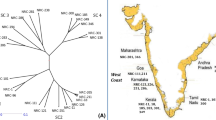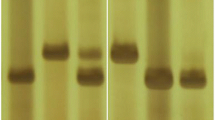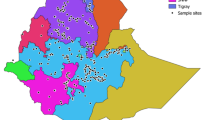Abstract
Hybridity and the genuineness of hybrids are prominent characteristics for quality control of seeds and thereby for varietal improvement. In the current study, the cross between two local barley genotypes (Ardhaoui: female; Testour: male) previously identified as susceptible/tolerant to salt stress in Tunisia was achieved. The hybrid genetic purity of the generated F1 putative hybrids and the fingerprinting of the parents along with their offspring were assessed using a set of 17 nuclear SSR markers. Among the analyzed loci, 11 nSSR were shown polymorphic among the parents and their offspring. Based on the applied 11 polymorphic SSR loci, a total of 28 alleles were detected with an average of 2.54 alleles per locus. The locus HVM33 presented the highest number of alleles. The highest polymorphism information content value was detected for the locus HVM33 (0.6713) whereas the lowest PIC value (0.368) was revealed by the loci BMAC0156, EBMAC0970 and BMAG0013 with a mean value of 0.4619. The probabilities of identical genotypes PI for the 11 microsatellite markers were 8.63 × 10−7. Banding patterns among parents and hybrids showed polymorphic fragments. The 11 SSR loci had produced unique fingerprints for each analyzed genotype and segregate between the two parental lines and their four hybrids. Parentage analysis confirms the hybrid purity of the four analyzed genotypes. Six Tunisian barley accessions were used as an outgroup in the multivariate analysis to confirm the efficiency of the employed 11 nSSR markers in genetic differentiation among various barley germplasms. Thus, neighbor joining and factorial analysis revealed clearly the discrimination among the parental lines, the four hybrids and the outgroup accessions. Out of the detected polymorphic 11 nuclear SSR markers, a set of five markers (HVM33, WMC1E8, BMAC0154, BMAC0040 and BMAG0007) were shown to be sufficient and informative enough to discriminate among the six genotypes representing the two parental lines and the four hybrids from each others. These five nSSR markers presented the highest number of alleles per locus (An), expected heterozygosity (He), PIC values and the lowest probabilities of identity (PI). These nSSR loci may be used as referral SSR markers for unambiguous discrimination and genetic purity assessment in barley breeding programs.



Similar content being viewed by others
References
Arya L, Verma M, Lakhanpaul S (2014) Diagnostic set of microsatellite markers for hybrid purity testing and molecular identification of hybrids and parental lines in sorghum. J Plant Sci Res 1:103
Belkhir K (1999) GENETIX version 4.02: a Windows program for population genetic analysis. Laboratoire genome, populations, interactions. UPR 9060. CNRS, Univ. Montpellier, Montpellier
Ben Chikha M (2017) Caractérisations physiologique biochimique et moléculaire de quelques écotypes locaux d’orge cultivés sous stress salin. Thesis dissertation, University of Sciences of Tunis
Ben Chikha M, Hessini K, Nefissi Ourteni R, Ghorbel A, Zoghlami N (2016) Identification of barley landrace genotypes with contrasting salinity tolerance at vegetative growth stage. Plant Biotechnol 32:1–9
Ben Romdhane M, Riahi L, Selmi A, Zoghlami N (2016) Patterns of genetic structure and evidence of gene flow among Tunisian Citrus species based on informative nSSR markers. C R Biol 339:371–377
Ben Romdhane M, Riahi L, Selmi A, Jardak R, Bouajila A, Ghorbel A, Zoghlami N (2017) Low genetic differentiation and evidence of gene flow among barley landrace populations in Tunisia. Crop Sci 57:1–9
Bohra A, Dubey A, Saxena RK, Penmetsa RV, Poornima KN, Kumar N, Farmer AD (2011) Analysis of BAC-end sequences (BESs) and development of BES-SSR markers for genetic mapping and hybrid purity assessment in pigeonpea (Cajanus spp.). BMC Plant Biol 11:56
Bohra A, Jha R, Pandey G, Patil PG, Saxena RK, Singh IP, Singh D, Mishra RK, Mishra A, Singh F, Varshney RK, Singh NP (2017) New hypervariable SSR markers for diversity analysis, hybrid purity testing and trait mapping in Pigeonpea [Cajanus cajan (L.) Millspaugh]. Front Plant Sci 8:377
Bora A, Choudhury PR, Pande V, Mandal AB (2016) Assessment of genetic purity in rice (Oryza sativa L.) hybrids using microsatellite markers. 3 Biotech 6:50
Bowers JE, Bandmann EB, Meredith CP (1993) DNA fingerprinting and characterization of some wine grape cultivars. Am J Enol Vitic 44:266–274
Chetan Kumar MR, Vishwanath K, Shivakumar N, Rajendra Prasad S, Radha BN, Ramegowda (2012) Utilization of SSR markers for seed purity testing in popular rice hybrids (Oryza sativa L.). Ann Plant Sci 1:1–5
Collard BCY, Jahufer MZZ, Brouwer JB, Pang ECK (2005) An introduction to markers, quantitative trait loci (QTL) mapping and marker assisted selection for crop improvement: the basic concepts. Euphytica 142:169–196
Gimhani DR, Kottearachchi NS, Samarasinghe WLG (2014) Microsatellite marker based hybridity assessment for salinity tolerance in rice. J Agric Sci 9:96–100
Harlan JR, Zohary D (1966) Distribution of wild wheats and barley. Science 153:1074–1080
Hipi A, Surahman M, Ilyas S, Giyanto (2013) Seed genetic purity assessment of maize hybrid using microsatellite markers. Int J Appl Sci Technol 3:66–71
Ju-Fen L, Guo-Bin M, Ling X (2008) SSR markers for identification of purity of melon hybrids. Chin J Agric Biotechnol 5:223–229
Kumar MBA, Sherry RJ, Varier A, Dadlani M (2007) Suitability of seed esterases for establishing distinctness, uniformity and stability of pearl millet genotypes. Curr Sci 93:951–956
Kumar MBA, Dadlani M, Kumar R, Jacob SR (2014) Identification and validation of informative SSR markers suitable for ensuring the genetic purity of brinjal (Solanum melongena L.) hybrid seeds. Sci Hortic 171:95–100
Kumar S, Jacob SR, Satyavathi CT, Dadlani M, Kumar MBA (2015) Utility of SSR markers in assessing the purity and identity of pearl millet hybrids. J Plant Biochem Biotechnol 25:121–124
Liu ZW, Biyashev RM, Saghai-Maroof MA (1996) Development of simple sequence repeat DNA markers and their integration into a barley linkage map. Theor Appl Genet 93:869–876
Macaulay M, Ramsay L, Powell W, Waugh RA (2001) Representative, highly informative ‘genotyping set’ of barley SSRs. Theor Appl Genet 102:801–809
Marshall TC, Slate J, Kruuk LEB, Pemberton JM (1998) Statistical confidence for likelihood-based paternity inference in natural populations. Mol Ecol 7:639–655
Mesfin AS, Dill-Macky R, Evans CK, Waugh R, Gustus CD, Muehlbauer GJ (2003) Quantitative trait loci for fusarium head blight resistance in barley detected in a two-rowed by six-rowed population. Crop Sci 43:307–318
Mezhnina VA, Urbanovich AY (2017) Study of genetic variability of Ribes L. representatives grown in Belarus. EuroBiotech J 1:184–187
Mylonas IG, Georgiadis A, Apostolidis AP, Bladenopoulos K, Koutsika-Sotiriou M (2014) Barley cultivar discrimination and hybrid purity control using RAPD markers. Rom Biotechnol Lett 19:9421–9428
Nagawade DR, Markad NR, Patil HT (2016) Hybridity and genetic purity testing of pearl millet [Pennisetum glaucum (L.) R. BR.] Hybrid Shraddha. Int J Adv Sci Eng Technol 4:131–135
Nei M (1978) Estimation of average heterozygosity and genetic distance from a small number of individuals. Genetics 89:583–590
Paetkau D, Calvert W, Stirling I, Strobeck C (1995) Microsatellite analysis of population structure in Canadian polar bears. Mol Ecol 4:347–358
Pali V, Verma SK, Xalxo MS, Saxena RR, Mehta N, Verulkar SB (2014) Identification of microsatellite markers for fingerprinting popular Indian flax (Linum usitatissimum L.) cultivars and their utilization in seed genetic purity assessments. Aust J Crop Sci 8:119–126
Pallavi HM, Gowda R, Shadakshari YG, Bhanuprakash K, Vishwanath K (2011) Identification of SSR markers for hybridity and seed genetic purity testing in sunflower (Helianthus annuus L.). HELIA 34:59–66
Perrier X, Flori A, Bonnot F (2003) Data analysis methods. In: Hamon P, Seguin M, Perrier X, Glaszmann JC (eds) Genetic diversity of cultivated tropical plants. Science Publishers, Montpellier, pp 43–76
Pope MN (1944) Some notes on technique in barley breeding. J Hered 35:99–111
Ramsay L, Macaulay M, Ivanissevich SD, Maclean K, Cardle L, Fuller J (2000) A simple sequence repeat-based linkage map of barley. Genetics 156:1997–2005
Riahi L, Ayari B, Zoghlami N, Dereeper A, Laucou V, Mliki A, This P (2013) High efficiency and informativeness of a set of SNP molecular markers in Tunisian local grapevines discrimination. Biochem Syst Ecol 51:175–183
Rostoks N, Mudie S, Cardle L, Russell J, Ramsay L, Booth A, Svensson T, Wanamaker S, Walia H, Rodriguez EM, Hedley PE, Liu H, Morris JH, Close T, Marshall D, Waugh Robbie (2005) Genome-wide SNP discovery and linkage analysis in barley based on genes responsive to abiotic stress. Mol Gen Genom 274:515–527
Saisho D, Takeda K (2011) Barley: emergence as a new research material of crop science. Plant Cell Physiol 52:724–727
Sannemann W, Huang BE, Mathew B, Leon J (2015) Multi-parent advanced generation inter-cross in barley: high-resolution quantitative trait locus mapping for flowering time as a proof of concept. Mol Breed 35:86
Subashini V, Shanmugapriya A, Yasodha R (2014) Hybrid purity assessment in Eucalyptus F1 hybrids using microsatellite markers. 3 Biotech 4:367–373
Tamilkumar P, Jerlin R, Senthil N, Ganesan KN, Jeevan RJ, Raveendran M (2009) Fingerprinting of rice hybrids and their parental lines using microsatellite markers and their utilization in genetic purity assessment of hybrid rice. Res J Seed Sci 2:40–47
Ullrich SE (2011) Significance, adaptation, production, and trade of barley. In: Ullrich SE (ed) Barley: production, improvement, and uses. Blackwell Publishing, Hoboken, pp 3–13
Wagner HW, Sefc KM (1999) Identity 1.0: freeware program for the analysis of microsatellite data. Manual program. Center for applied genetics, Univ. of Agricultural Sciences, Vienna
Wang J, Zhong GY, Chin ECL, Register JC, Riley RD, Nieber WS, Smith JSC (2002) Identification of parents of F1 hybrids through SSR profiling of maternal and hybrid tissue. Euphytica 124:29–34
Zoghlami N, Chrita I, Bouamama B, Gargouri M, Zemni H, Ghorbel A, Mliki A (2007) Molecular based assessment of genetic diversity within Barbary fig (Opuntia ficus indica L.) in Tunisia. Soc Hort Sci 2:134–141
Zoghlami N, Bouagila A, Lamine M, Hajri H, Ghorbel A (2011) Population genetic structure analysis in endangered Hordeum vulgare landraces from Tunisia: conservation strategies. Afr J Biotechnol 10:10344–10351
Author information
Authors and Affiliations
Corresponding author
Ethics declarations
Conflict of interest
Authors declare no conflict of interest.
Rights and permissions
About this article
Cite this article
Ben Romdhane, M., Riahi, L., Jardak, R. et al. Fingerprinting and genetic purity assessment of F1 barley hybrids and their salt-tolerant parental lines using nSSR molecular markers. 3 Biotech 8, 57 (2018). https://doi.org/10.1007/s13205-017-1080-3
Received:
Accepted:
Published:
DOI: https://doi.org/10.1007/s13205-017-1080-3




